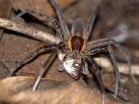Fish-eating spiders discovered in all parts of the world
2014-06-19
(Press-News.org) Spiders are traditionally viewed as predators of insects. Zoologists from Switzerland and Australia have now published a study that shows: spiders all over the world also prey on fish. The academic journal PLOS ONE has just published the results.
Although viewed by ecologists as the classical predators of insects, researchers have become increasingly aware that spiders are not exclusively insectivorous. Certain larger-sized species supplement their diet by occasionally catching small fish. This shows a new study by zoologist and spider expert, Martin Nyffeler from the University of Basel, Switzerland and Bradley Pusey from the University of Western Australia. The researchers gathered and documented numerous incidents of spiders predating fish from all around the world.
Fish as a diet supplement
According to their systematic review, spiders from as many as five families have been observed predating on small fish in the wild and three more families contain species that catch fish under laboratory conditions. These so called semi-aquatic spiders typically dwell at the fringes of shallow freshwater streams, ponds or swamps. These spiders, some of which are capable of swimming, diving and walking on the water surface, have powerful neurotoxins and enzymes that enable them to kill and digest fish that often exceed them in size and weight. “The finding of such a large diversity of spiders engaging in fish predation is novel. Our evidence suggests that fish might be an occasional prey item of substantial nutritional importance”, says Martin Nyffeler.
Based on this study, naturally occurring fish predation by spiders has been reported from all continents with the exception of Antarctica. Most incidents have been documented in North America, especially in the wetlands of Florida, where semi-aquatic spiders have often been witnessed catching and eating small freshwater fish such as mosquitofish. In order to catch its prey, the spider will typically anchor its hind legs to a stone or a plant, with its front legs resting on the surface of the water, ready to ambush. The fish will then be dragged to a dry place before the feeding process can begin which usually lasts several hours.
INFORMATION:
Original source
Martin Nyffeler & Bradley Pusey (2014) Fish Predation by Semi-Aquatic Spiders: A Global Pattern. PLOS ONE http://dx.plos.org/10.1371/journal.pone.0099459
Further information
PD Dr. Martin Nyffeler, Department of Environmental Sciences, University of Basel, phone: +41 61 702 07 03, email: martin.nyffeler@unibas.ch
Related sites
Environmental Sciences > https://conservation.unibas.ch/team/nyffeler/ END
ELSE PRESS RELEASES FROM THIS DATE:
Many doctors concerned about physician involvement in concealed-weapon permit process
2014-06-19
A new survey of North Carolina doctors finds that many are concerned about the increasing number of requests they are receiving to assess their patients' competency to carry concealed weapons.
In particular, a majority of physicians who responded to the survey said they were worried about the potential ethical consequences in the doctor-patient relationship if they participated in the concealed-weapon permit process.
"This is not a small problem," said Dr. Adam Goldstein, corresponding author of the study and a professor in the Department of Family Medicine at the University ...
New report offers a primer for doctors' use of clinical genome and exome sequencing
2014-06-19
Sooner than almost anyone expected, a new, genome-based technology for demystifying undiagnosed illnesses—particularly rare childhood diseases—is moving from research laboratories into general medical practice. Now, two leading scientists have sketched out what doctors need to know in order to use the new technology effectively.
"This primer illustrates how rapidly the use of genome sequencing has moved into clinical practice," said NHGRI Director Eric D. Green, M.D., Ph.D. "Its authors lay out an approach for physicians to follow when using these exciting new technologies." ...
Genomic technology enters the mainstream practice of medicine
2014-06-19
BOSTON, MA – Clinical genome and exome sequencing (CGES) was once deemed exotic, but is increasingly being used by clinical geneticists and other specialists to diagnose rare, clinically unrecognizable, or puzzling disorders that are suspected to be genetic in origin. Several thousand CGES tests across the country have already been ordered for patients and thousands more are expected in coming years. CGES is quickly moving from research laboratories into clinical medical practice, across all specialties.
A review article titled, "Diagnostic Clinical Genome and Exome ...
Broken gene found to protect against heart disease
2014-06-19
Cambridge, Mass. Wed. June 18, 2014 – By scouring the DNA of thousands of patients, researchers at the Broad Institute, Massachusetts General Hospital, and their colleagues have discovered four rare gene mutations that not only lower the levels of triglycerides, a type of fat in the blood, but also significantly reduce a person's risk of coronary heart disease — dropping it by 40 percent. The mutations all cripple the same gene, called APOC3, suggesting a powerful strategy in developing new drugs against heart disease. The work, which appears in the June 18 issue of the ...
Genomic 'dark matter' of embryonic lungs controls proper development of airways
2014-06-19
PHILADELPHIA – It's a long way from DNA to RNA to protein, and only about two percent of a person's genome is eventually converted into proteins. In contrast, a much higher percentage of the genome is transcribed into RNA. What these non-protein-coding RNAs do is still relatively unknown. However, given their vast numbers in the human genome, researchers believe that they likely play important roles in normal human development and response to disease.
Large-scale sequencing has allowed investigators to identify thousands of non-coding RNAs. Small non-coding RNAs, including ...
New research can improve heart health
2014-06-19
Danish researchers from the University of Copenhagen and Rigshospitalet have shown that people with variation in a gene that inhibits a specific protein in the blood – the so-called apolipoprotein C3 – have a significantly lower level of normal blood lipids than people without this gene variation. Furthermore, the same individuals also have a 41 per cent lower risk of arteriosclerosis.
The research is highly relevant as at least one pharmaceutical company has a drug in the pipeline which inhibits precisely apolipoprotein C3, says Anne Tybjærg-Hansen, Chief Physician ...
Portable brain-mapping device allows UT Arlington researchers to 'see' where memory fails
2014-06-19
UT Arlington researchers have successfully used a portable brain-mapping device to show limited prefrontal cortex activity among student veterans with Post Traumatic Stress Disorder when they were asked to recall information from simple memorization tasks.
The study by bioengineering professor Hanli Liu and Alexa Smith-Osborne, an associate professor of social work, and two other collaborators was published in the May 2014 edition of NeuroImage: Clinical. The team used functional near infrared spectroscopy to map brain activity responses during cognitive activities related ...
Group doctor visits may improve life for people with muscle disorders
2014-06-18
MINNEAPOLIS – A new study suggests that people with muscle diseases such as muscular dystrophies may benefit more from group doctor visits than individual appointments. The study is published in the June 18, 2014, online issue of Neurology®, the medical journal of the American Academy of Neurology.
"In this age when the demand for neurologists is rising faster than the supply and health care costs continue to rise, it's important to look for finding solutions that are both effective and efficient," said study author Femke M. Seesing, MSc, of Radboud University Medical ...
Depression linked to higher heart disease death risk in younger women
2014-06-18
Women 55 and younger are twice as likely to suffer a heart attack, die or require artery-opening procedures if they're moderately or severely depressed, according to new research in the Journal of the American Heart Association.
"Women in this age group are also more likely to have depression, so this may be one of the 'hidden' risk factors that can help explain why women die at a disproportionately higher rate than men after a heart attack," said Amit Shah, M.D., M.S.C.R., study author and assistant professor of Epidemiology at Emory University in Atlanta, Ga.
Investigators ...
Racial disparities in sentinel lymph node biopsy in women with breast cancer
2014-06-18
The use of sentinel lymph node biopsy (SLNB) to stage early breast cancer increased in both black and white women from 2002 to 2007, but the rates remained lower in black than white patients, a disparity that contributed to disparities in the risk for lymphedema (arm swelling common after breast cancer treatment because of damage to the lymphatic system).
SLNB was developed to replace axillary (arm pit) lymph node dissection (ALND) for staging early breast cancer to minimize complications. SLNB can often provide patients with a much more limited surgery. Racial ...





